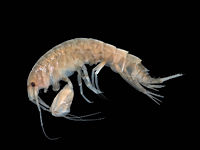Portal:Crustaceans
The Crustaceans Portal Crustaceans are a group of arthropods that are a part of the subphylum Crustacea (/krəˈsteɪʃə/), a large, diverse group of mainly aquatic arthropods including decapods (shrimps, prawns, crabs, lobsters and crayfish), seed shrimp, branchiopods, fish lice, krill, remipedes, isopods, barnacles, copepods, opossum shrimps, amphipods and mantis shrimp. The crustacean group can be treated as a subphylum under the clade Mandibulata. It is now well accepted that the hexapods (insects and entognathans) emerged deep in the Crustacean group, with the completed group referred to as Pancrustacea. The three classes Cephalocarida, Branchiopoda and Remipedia are more closely related to the hexapods than they are to any of the other crustaceans (oligostracans and multicrustaceans). The 67,000 described species range in size from Stygotantulus stocki at 0.1 mm (0.004 in), to the Japanese spider crab with a leg span of up to 3.8 m (12.5 ft) and a mass of 20 kg (44 lb). Like other arthropods, crustaceans have an exoskeleton, which they moult to grow. They are distinguished from other groups of arthropods, such as insects, myriapods and chelicerates, by the possession of biramous (two-parted) limbs, and by their larval forms, such as the nauplius stage of branchiopods and copepods. Most crustaceans are free-living aquatic animals, but some are terrestrial (e.g. woodlice, sandhoppers), some are parasitic (e.g. Rhizocephala, fish lice, tongue worms) and some are sessile (e.g. barnacles). The group has an extensive fossil record, reaching back to the Cambrian. More than 7.9 million tons of crustaceans per year are harvested by fishery or farming for human consumption, consisting mostly of shrimp and prawns. Krill and copepods are not as widely fished, but may be the animals with the greatest biomass on the planet, and form a vital part of the food chain. The scientific study of crustaceans is known as carcinology (alternatively, malacostracology, crustaceology or crustalogy), and a scientist who works in carcinology is a carcinologist. (Full article...) Selected article
Dyspanopeus sayi is a species of mud crab that is native to the Atlantic coast of North America. It has also become established outside its native range, living in Swansea Docks since 1960, the Mediterranean Sea since the 1970s, the North Sea since 2007 and the Black Sea since 2010. It can reach a carapace width of 20 mm (0.8 in), and has black tips to its unequal claws. It feeds on bivalves and barnacles, and is in turn eaten by predators including the Atlantic blue crab, Callinectes sapidus. Eggs are produced from spring to autumn, the offspring reach sexual maturity the following summer, and individuals can live for up to two years. The closest relative of D. sayi is D. texanus, which lives in the Gulf of Mexico; the two species differ in subtle features of the genitalia and the last pair of walking legs.
Did you know?
Selected biography
Robert Gurney (July 31, 1879 – March 5, 1950) was a British zoologist most famous for his monographs on British Freshwater Copepoda (1931–1933) and the Larvae of Decapod Crustacea (1942). He was born in 1879 as the fourth son of John Gurney and Isabel Charlotte Gurney (later Baroness Talbot de Malahide) of Sprowston Hall, Norfolk. He went to school at Eton College, and went on to study at New College, Oxford, graduating with first class honours in 1902. He was never associated with any institution, but worked from his home, initially in Norfolk, but later at Boars Hill. Realising the need for a specialist field station for freshwater biology to match the marine biological stations at Plymouth and Naples, Robert and his brother Eustace set up Great Britain's first freshwater laboratory at Sutton Broad. Gurney's two great study objects were the Copepoda and the larvae of Decapoda (zoea larva of Homarus gammarus pictured), and his greatest works were the three-volume monograph British Freshwater Copepoda, published by the Ray Society in 1931–1933, and his Larvae of Decapod Crustacea published by the Ray Society in 1942. Gurney travelled to North Africa and Bermuda, and received material from other foreign expeditions, including the Terra Nova Expedition (1910–1913) and the Discovery Investigations of the 1920s and 1930s.
Selected image Periclimenes imperator (Decapoda: Palaemonidae) is a species of shrimp with a wide distribution across the Indo-Pacific that lives commensally on a number of hosts, including the sea slug Hexabranchus. General imagesThe following are images from various crustacean-related articles on Wikipedia.
Crustacean lists
SubcategoriesRelated portalsWikiProjectsAssociated WikimediaThe following Wikimedia Foundation sister projects provide more on this subject:
Discover Wikipedia using portals
|





















































